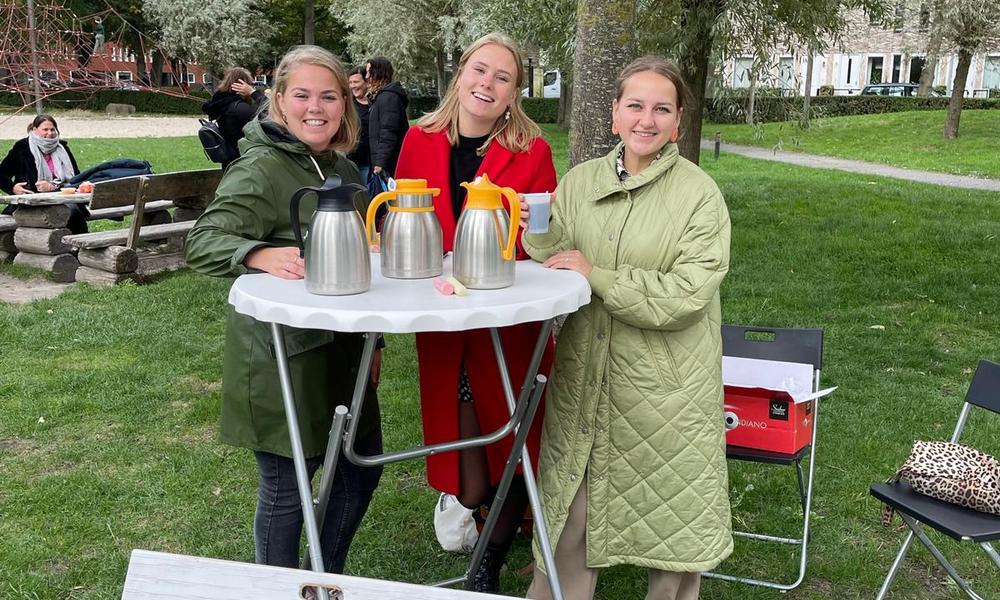Making Indische Buurt healthier, greener and safer
- News

Making the Indische Buurt healthier, greener and safer. In Living Lab The Healthy City students from various disciplines are doing research in Indische Buurt. They design and research innovative ideas for the neighborhood, together with Wijklab Floreshuis. Otto Lussenburg and Marlieke Kremer explain.
'A Living Lab is a place where students from various study programmes do research together and try to find answers to questions. There are all kinds of questions in Indische Buurt, one of the poorest neighborhoods in the Netherlands," Otto Lussenburg explains. The teacher-researcher from Research Centre for Built Environment NoorderRuimte has been involved in the project since 2018. Otto: 'The idea behind The Healthy City (dutch) is: let's ask the residents themselves how the neighbourhood can become more fun and better.'
Marlieke Kremer is graduating from The Healthy City. The fourth-year Social Work student investigated the safety of Oosterhamriklaan, the road that separates Molukkenplantsoen and West India Neighborhood. With her study buddy Nanne ten Hoor and a camera, she went into the neighbourhood to ask residents: what are you proud of? Marlieke: 'And what was the outcome? The residents are proud of the social connection, the play opportunities, the many green spaces and that they can walk the streets relatively safely. But at the same time they cannot deny that it is a disadvantaged neighbourhood. Although they prefer not to call it that. Over the past six months I have become more or less part of the neighbourhood, I feel.'
The residents were less enthusiastic about the safety of Oosterhamriklaan. Marlieke: 'Through conversations with school children, local residents and professionals, we discovered that it is not safe to cross from West-Indische Buurt to Molukkenplantsoen. Together we came up with concepts to make it safer and create more connection. It doesn't get much more practical than this. We provided the municipality with tools that we hope they will implement. What we came up with together with the neighbourhood is a median strip with more greenery, the maximum speed from 50 to 30, a meeting place with greenery and benches. And a lighted crosswalk that allows you to cross safely. We also recommend an illuminated and elevated path for pedestrians and cyclists. Once people feel safer, they feel more connection with the neighbourhood and residents seek each other out more easily.'
Every Thursday morning the students met at community center the Flores House. 'Each semester, about 16 to 18 students from 8 to 10 different programs participate in the research,' Otto adds. 'A Minerva student develops a work of art for the neighbourhood. There are Architecture students involved, Product Designers, Social Work students, (International) Facility Managers. An app was developed that allows residents to report unsafe situations in the neighbourhood to the municipality in a very simple way. In doing so, they themselves can come up with appropriate solutions or ideas. Students do new research or build on research done by students in previous semesters. We have been in the district for four years. For example, an exercise path has been developed, on which children get moving almost automatically. It's just barely finished, and a new group of Applied Psychology students is now going to develop it further.'
'We can learn an enormous amount from each other,' Marlieke believes. 'Especially from all those different perspectives. By engaging in conversation together, you come up with completely different ideas for the same problem.
Another question students have considered is: how can Molukkenplantsoen become more fun? Otto: "It's a nice park, but people keep leaving. What's wrong with it? Last year we took stock of the fact that high bushes, places where vicious looking characters hang out and the lack of lighting make the park unattractive. One of the recommendations was: a meeting place. A Built Environment student designed a spot for the park bench that is part of an already existing route of a living room coffee route. Marlieke and Nanne handed out coffee in the parkway with the cargo bike. In Indische Buurt you should not arrive with a trendy coffee shop, but with something accessible.
The new group of students who started in February will, among other things, work on the redevelopment of Floresplein. There the sewers will be replaced after which we can fill in a kind of blank canvas. It has to become climate-proof. We will include flooding and heat stress in the plans. We also want to stimulate playing, exercising and meeting at that location. We are going to do that together with the residents," Otto concludes.
How satisfied are you with the information on this page?